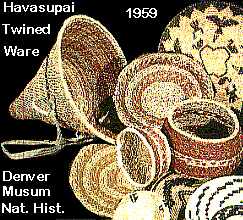| Havasupai tribe, down a precipitous 8-mile trail from rim to bottom of the Grand Canyon, is still accessible only by foot or on horseback -- or Internet! They kept a need for basketry for everyday use longer than most. This is Chek-a-panga's wife, photographed there in 1901. | 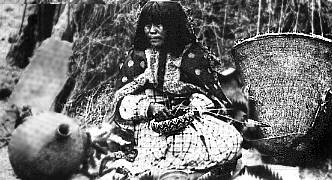 |
|---|---|
| At left are a peach, red clay and piñon-coated water jug, a large burnt peach-coated parching tray, and at the right, a twined conical burden basket (cathok). She's working on a coiled-ware bowl. of the type made today for tourist and collector sales, but she's surrounded by her traditional food gathering and preparation basketry. | |
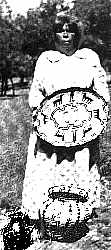 Mamie Watahomigie was photographed at Grand Canyon Village in 1934. She holds a fine oval coiled tray, with a coiled olla-shaped basket at her feet. Both use her deer motif patterns. A finished, piñon-pitch coated, waterproofed water jug is also at her feet. Mamie wove the pinkish water jug (clay and pitch weren't added) at the top of the page, here, in 1930. Many of her baskets are in the collection of Barbara and Edwin McKee, National Park supervisors from 1930-40. The McKees encouraged Havasupai basketmakers to revive the dying art, and to make fine coiled ware, more popular with tourists than rough twined ware for utility. They collected 184 baskets from 32 makers to document a peak period of Havasupai basketry. | |
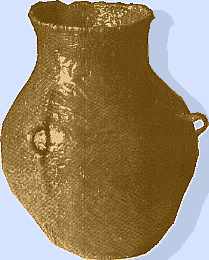 |
Apache water jug made by San Carlos (northern) Apache basketmaker Lola Tuse in 1984 is 20 " high by 15.5" in diameter. It is basket-woven of twined sumac, thickly coated inside and out with hot piñon pitch. Corked, it keeps water cool for hours as well as a thermos jug (and gives it a slight piney flavor). These traditional jugs were lightweight, unbreakable, easy to carry, and could be hung up by pitch-coated twigs at the sides of the jug. The Havasupai peach pulp coating (top of page, left) supplements piñon, which didn't grow in abundance down in the hot canyon. (Peaches have long been a traditional Havasupai crop.) Southern Apache women made water jugs coated with piñon pitch only on the inside. |
| This 10 x 6.5" basket-water jug was made around 1900, by a woman in Yosemite Mono Carrie Bethel's family. It's coated with white pine pitch, mixed with a soapwood root paste. A much thinner, more transparent coating (which is flexible and waterproof but not so good an insulator) was achieved with that combination. | 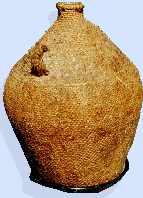 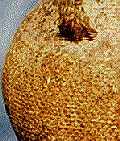 |
Willow and redbud, twined, not coiled, is what it's made of. Detail of the weaving shows both that this kind of coating lets the weaving be mostly visible, and that the coating was made thicker around the hanging-and-handling shoulder, which received the most wear. Jug is standing on a black ring, which is not part of it. | |
| Though basketry was usually womens' work, Califnrnia Pomo men did a variety of practical rough basket weaving. Fish entered the inner funnel of this basket trap and then were unable to find their way out. | 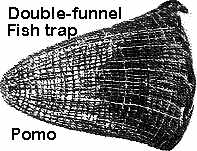 |
 | |
| Long fish basket trap, mounted so current poured through its mouth. Fish, swimming in, could not turn around or swim out against the current. | |
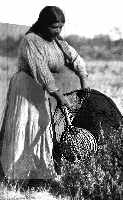 This photo of a Pomo woman beating seeds into her funnel-shaped basket was taken by Edwin Curtis around 1900. It shows the functional intelligence of the universal design of what anthros call "burden baskets". With a broad, wicker basket seed-beater (traditionally part of men's work), she whacks the tops of plants whose ripe, dried pods are ready to shatter. The heavier seeds fly down into the funnel, and the lighter pod trash stays at the wide mouth (facing us here), where it can be brushed out easily, thus harvesting and threshing with one blow -- with the right basket tools. This photo of a Pomo woman beating seeds into her funnel-shaped basket was taken by Edwin Curtis around 1900. It shows the functional intelligence of the universal design of what anthros call "burden baskets". With a broad, wicker basket seed-beater (traditionally part of men's work), she whacks the tops of plants whose ripe, dried pods are ready to shatter. The heavier seeds fly down into the funnel, and the lighter pod trash stays at the wide mouth (facing us here), where it can be brushed out easily, thus harvesting and threshing with one blow -- with the right basket tools. | |
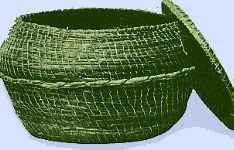 |
Ojibwe and Ho-Chunk (Winnebago) women of the Great Lakes region made large sweetgrass baskets to store small fur and leather garments to keep them sweet-smelling. Very small ones kept children's navel cords. These baskets are still made for special purposes now. Sweetgrass stems -- leaves are not used, they crumble on drying -- are bundled, then sewn for soft, flexible scented baskets, which are replaced when the grass loses its sweet scent. |
| Sweetgrass (Hierochloe odorata) grows in swampy areas in the midwest. It's picked in summer, while green, once the flower stalk is high. Leaves are stripped off and the stalks are dried in the shade, to stay green. The sweet smell only develops when it's dried. Some will be braided in thick braids for ceremonial incense. Pencil-sized bundles of stems split with a fingernail are sewn with black threads fairly far apart in diagonal stitches, like the one shown here. Big baskets will have bottoms of a birch-bark circle, and lids are either made of birchbark or braced by coiling on a circle of it, with a bundle of sweetgrass whipped around the edge. Fancy quilled lids are somtimes made. Sweetgrass braids and baskets should only be given away, not sold. Sweetgrass is sacred; baskets and smudging braids are made only for sacred purposes. | |
| Ojibwe and other women made quick and rough split willow wicker (simple over-and-under weave) baskets for utility. This "melon shape" was one of the commonest. This one, photographed in the early 1900's, at White Earth reservation (MN) used blighted stripped twigs for the green and red stripes, and twigs with bark left on wrapped the handle. | 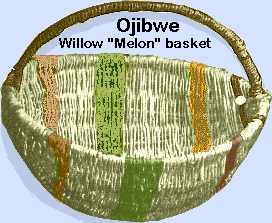 |
| No one has made these for a long time, but the language preserves the word for them: oziisigobimizhii-makkak. | |

